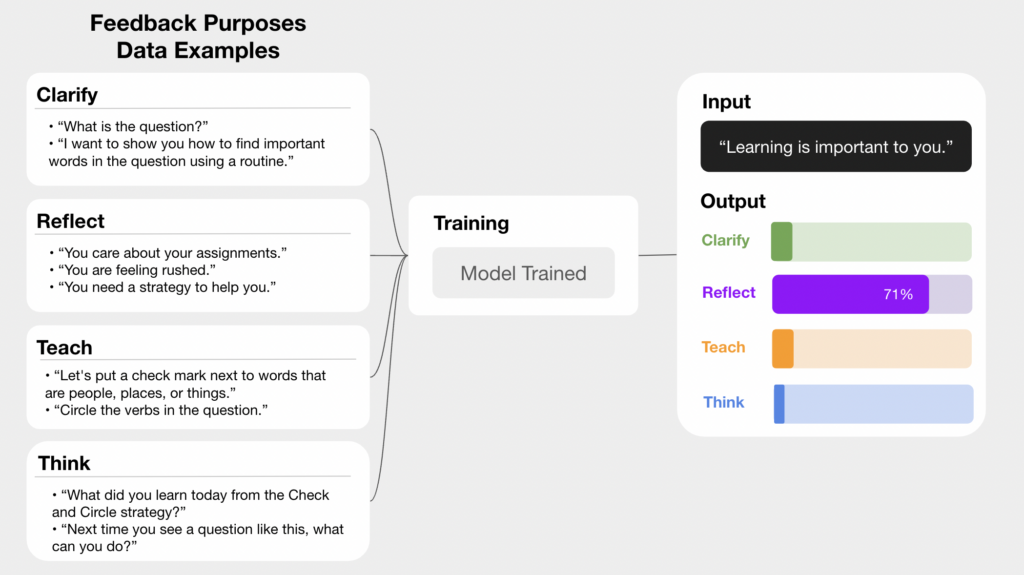Our Technology
Teaching with Grace and Artificial Intelligence
Teaching with Grace was first developed at the University of Virginia School of Education and Human Development as Liz (2017). Liza was originally named in recognition of the Eliza program created in 1966 by MIT computer scientist Joseph Weizenbaum. Eliza used simple technology to simulate the discourse between a Rogerian-style psychotherapist and patient. The “patient” would type to the program and the program would respond by simple word matching with vague responses such as “How did that make you feel?” and “Tell me more about that.” Weizenbaum found that people felt talking with ELIZA was comforting. This research highlighted how people may suspend their disbelief with very little realism and become affectively engaged with simple interactions.
Liza was reimagined as Teaching with Grace as part of Reach Every Reader at the Harvard Graduate School of Education (2021). The project gratefully acknowledges the support of the Chan Zuckerberg Initiative. https://reacheveryreader.gse.harvard.edu/ Teaching with Grace reflects the graceful movement of teaching and the agile teacher thinking, and caring required to ensure students with diverse strengths and needs benefit from every lesson. Teaching with Grace is named after Grace Hopper, a pioneer in computing engineering. Harvard Gazette – Grace Hopper, computer pioneer.
How Teaching with Grace Works

Teaching with Grace was developed through the Computing Integrated Teacher Education (CITE) project (June, 2023). https://www.cuny.edu/academics/academic-programs/teacher-education-programs/computing-integrated-teacher-education/ Agility was developed through Reach Every Reader at the Harvard Graduate School of Education, supported by the Chan Zuckerberg Initiative. The Teaching Routine Cards are based on the book: Bondie, R & Zusho, A. (2018). Differentiated Instruction Made Practical. Routledge.
Reference
Weizenbaum, J. (1966). ELIZA—a computer program for the study of natural language communication between man and machine. Communications of the ACM, 9(1), 36-45.
Open Source Software
Teaching with Grace and Agility have been designed by the development team to provide freely available and open-source tools aimed at developing teaching practices for inclusive classrooms. Learn more about the tools below and click here to learn how to use these tools in teacher education and the teaching practices research-base.
Teaching with Grace is released under the MIT license https://github.com/bferster/liza
Agility is released under the MIT license https://github.com/bferster/agame
Data Collected
Similar to all online activities, our software collects information from you so that you can rejoin an experience in case you accidentally close out or lose your connection. We also monitor how many users engage with our tools and the amount of time users spend learning. We do not share data outside of our project team. We list specifically below, by product, the data collected, storage, and length of storage.
Teaching with Grace
- name and email ( we do not share emails)
- actions, words, and system analyses of words
Agility Data
- name and email
- selected cards to make past games info available only to the player
- users may view previous game card selections on the scoreboard
Privacy
- We do not share any information outside of the product team.
- Data is stored for 10 years and may be used to evaluate product effectiveness. Aggregate data may be shared to describe teacher learning using Agility and Teaching with Grace.
Chrome Browser and Text to Speech
Teaching with Grace uses the free speech-to-text part of the Chrome browser. Teachers must allow www.agileteacher.org to access the microphone on their device for the system to translate speech into text and then reply with an appropriate student response.
AI Engine
Teaching with Grace is powered by a machine learning system that has been trained based on English language models using wit.ai. The team developed a language model by first observing hundreds of teachers engaging in teaching tasks similar to those used in Teaching with Grace. After developing possible teacher responses, the responses were translated into different languages (e.g. Spanish and French) and then back to English to develop a training data set. Teaching with Grace uses this language model to analyze teacher feedback given to avatar students and can currently code teacher feedback into five different purposes (i.e. general, clarify, reflect, redirect, and think).
Student responses were created by the development team. Student responses are not generated by AI. There are a finite number of student responses that have been constructed to express feelings of belonging, academic language, knowledge, and thinking. Students do not have a stereo-typical profile. Avatar students express strengths and needs based in response to the task and context.
3D Environment
We believe a minimalist rendering of the virtual student may allow teachers to concentrate on practicing listening to students and responding with high quality feedback without being swept up in the personification of a specific student. We believe the specific skill practice opportunities provided through Teaching with Grace may potentially generalize. Scott McCloud deftly described the process as amplification through simplification and is a long recognized principle in the use of images in instruction where extraneous elements are eliminated in order to focus attention on the primary goal.
